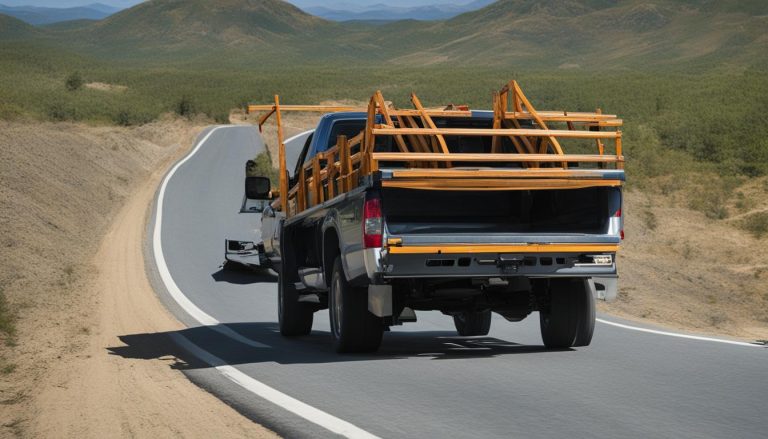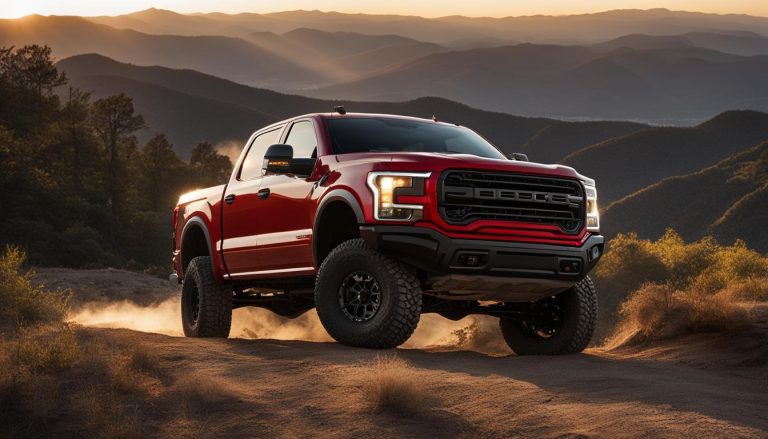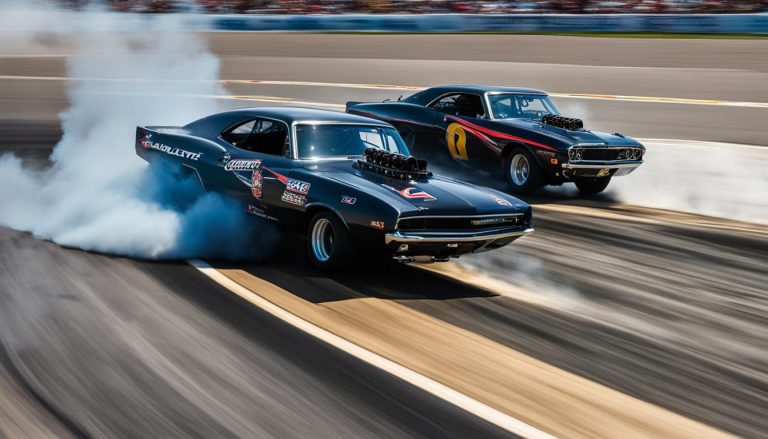Ladder Bars vs Traction Bars: Performance Face-off
If you want to upgrade your vehicle’s performance, having the right suspension upgrades can make a significant difference. Two popular options that many car enthusiasts consider are ladder bars and traction bars. But what exactly are the differences between these two? And how do they impact your vehicle’s performance? Let’s find out.
Key Takeaways:
- Ladder bars and traction bars offer distinct benefits for improving vehicle performance.
- Ladder bars provide better traction and stability by controlling axle wrap and wheel hop.
- Traction bars enhance traction and acceleration by preventing axle wrap and wheel hop.
- Factors to consider when choosing between ladder bars and traction bars include installation, adjustability, and cost.
- Consulting with experts and researching specific applications can help you make an informed decision.
Benefits of Ladder Bars
Ladder bars provide a host of advantages for vehicle performance, offering improved traction and increased stability. These robust suspension components are particularly useful for off-road vehicles and drag race cars, where enhanced traction and stability are crucial for optimal performance.
One of the key benefits of ladder bars is their ability to control axle wrap and limit wheel hop. By reducing the movement of the axle during acceleration, ladder bars help maintain constant tire contact with the road or track, resulting in better traction. This increased traction allows for smoother acceleration and improved handling.
“Ladder bars are essential for off-road enthusiasts and drag racers looking to maximize traction and stability.” – John Anderson, Racing Enthusiast
Furthermore, ladder bars offer increased stability by minimizing the chassis movement and preventing excessive weight transfer during acceleration. This stability translates into improved control and handling, allowing drivers to navigate challenging terrains or tracks with confidence.
Whether you’re conquering off-road trails or dominating the drag strip, ladder bars can significantly enhance your vehicle’s performance. Let’s explore a real-world example of their impact:
Imagine tackling a steep incline or launching your car down a quarter-mile drag strip. Without ladder bars, your vehicle may struggle with axle wrap, causing uneven weight distribution and reduced traction. However, by installing ladder bars, you can effectively control axle movement, ensuring maximum tire grip and better acceleration.
Enhanced traction and stability are just a few of the benefits ladder bars bring to the table. In the next section, we will delve into the advantages of traction bars and how they can improve vehicle performance and driveability.
Benefits of Traction Bars
Traction bars are an essential component for improved vehicle performance, offering several key benefits that enhance driveability and overall handling. By addressing issues like axle wrap and wheel hop, traction bars effectively optimize traction and acceleration, particularly in high-performance applications. Let’s explore some of the top advantages:
- Prevention of Axle Wrap: Traction bars help mitigate axle wrap, which occurs when the rotational force generated by the engine causes the rear axle to twist. This twisting motion can negatively impact traction, resulting in poor performance and compromised handling. Traction bars effectively counter this problem, providing greater stability and control.
- Elimination of Wheel Hop: Wheel hop is a common issue during hard acceleration, characterized by the rear wheels rapidly alternating between gripping and losing traction. This phenomenon not only hampers acceleration but also puts strain on various drivetrain components. By limiting wheel hop, traction bars ensure smoother power transfer to the wheels, improving overall traction and stability.
- Enhanced Traction: With their ability to minimize axle wrap and wheel hop, traction bars significantly enhance traction. By keeping the rear tires planted firmly on the ground, traction bars allow for increased power delivery and improved acceleration. This is particularly beneficial in performance-oriented vehicles, where maximizing traction is crucial.
- Improved Driveability: By optimizing traction and reducing unwanted wheel movement, traction bars contribute to enhanced driveability. They provide better control and stability during acceleration, cornering, and even heavy braking, resulting in a more enjoyable and confidence-inspiring driving experience.
Traction bars are a valuable addition to any vehicle seeking improved performance. The benefits they offer, including enhanced traction, prevention of axle wrap and wheel hop, and overall driveability improvements, make them a popular choice among car enthusiasts and professional racers alike.
“Traction bars effectively optimize traction and acceleration, particularly in high-performance applications. By addressing issues like axle wrap and wheel hop, they provide better control and stability, resulting in a more enjoyable and confidence-inspiring driving experience.”
Comparison of Traction Bars and Ladder Bars
| Category | Traction Bars | Ladder Bars |
|---|---|---|
| Installation | May require more creativity for front mount locations | Easier to install |
| Adjustability | Offers better suspension travel and articulation without binding | Provide a symmetrical look |
| Cost | Vary depending on brand and type | Similarly priced to traction bars |
When considering the decision between traction bars and ladder bars, it’s essential to evaluate factors such as installation, adjustability, and cost. Traction bars may require some creativity during installation, especially when determining suitable front mount locations. However, they offer better suspension travel and articulation without binding. On the other hand, ladder bars are generally easier to install and provide a symmetrical look. Both traction bars and ladder bars are priced similarly, making the choice dependent on individual preferences and specific vehicle needs.
Ladder Bars vs Traction Bars Comparison
When choosing between ladder bars and traction bars, various factors need to be taken into account for an informed decision. These factors include installation, adjustability, and cost. Let’s compare ladder bars and traction bars to understand their unique characteristics and benefits.
Ladder Bars
Ladder bars are known for their ease of installation and symmetrical look. They are typically attached to the rear axle and chassis, providing enhanced stability and control. Ladder bars control axle wrap and limit wheel hop, resulting in improved traction and handling. They are commonly used in off-road vehicles and drag race cars due to their ability to handle high torque loads.
Traction Bars
Traction bars, on the other hand, may require a bit more creativity during installation, particularly when determining front mount locations. However, they offer advantages such as better suspension travel and articulation without binding. Traction bars are designed to prevent axle wrap and wheel hop, leading to improved traction and smoother acceleration. They are beneficial for achieving enhanced driveability, especially in high-performance applications.
Both ladder bars and traction bars play a crucial role in reducing axle wrap and wheel hop, which in turn enhances traction and overall vehicle performance.
Choosing Between Ladder Bars and Traction Bars
Choosing between ladder bars and traction bars ultimately depends on individual preferences and specific vehicle needs. To make an informed decision, consider the following factors:
- Installation: Ladder bars are generally easier to install, while traction bars may require a little more effort and creativity for front mount locations.
- Adjustability: Depending on your requirements, evaluate the adjustability offered by both options to ensure they meet your desired performance goals.
- Cost: Consider your budget when comparing ladder bars and traction bars, as their prices may vary.
By carefully weighing these factors, you can select the option that best suits your needs and preferences. Remember to consult with experts or conduct thorough research to make an informed decision.

| Ladder Bars | Traction Bars |
|---|---|
| Easier installation | Requires more creativity for front mount locations |
| Symmetrical look | Offers better suspension travel and articulation without binding |
| Effective in controlling axle wrap and wheel hop | Prevents axle wrap and wheel hop for improved traction |
Conclusion: Making the Right Choice
In conclusion, when deciding between ladder bars and traction bars, it’s important to consider the individual preferences and specific requirements of your vehicle. Both options have their advantages and disadvantages, so making the right choice depends on several factors.
Firstly, consider the ease of installation. Ladder bars are generally easier to install and offer a symmetrical look. On the other hand, traction bars may require more creativity for front mount locations but can provide better suspension travel and articulation without binding.
Secondly, think about adjustability. Some prefer ladder bars for their simplicity and reliable performance, while others opt for traction bars for their ability to fine-tune suspension settings for different driving conditions.
Lastly, consider the expected performance improvements. Both ladder bars and traction bars can significantly improve vehicle performance and handling by reducing axle wrap and wheel hop, resulting in better traction and stability.
To make an informed decision, it’s recommended to consult with an expert or do thorough research on specific applications that align with your vehicle’s needs. By considering factors like ease of installation, adjustability, and expected performance improvements, you can confidently choose between ladder bars and traction bars to enhance your vehicle’s performance.
FAQ
What are ladder bars and traction bars?
Ladder bars and traction bars are aftermarket suspension components designed to improve vehicle performance and traction. They work by controlling axle wrap and limiting wheel hop, resulting in better traction and enhanced handling.
How do ladder bars improve vehicle performance?
Ladder bars offer several benefits, including improved traction and increased stability. They effectively control axle wrap and prevent wheel hop, resulting in better traction and improved handling. Ladder bars are particularly valuable for off-road vehicles and drag race cars.
What are the benefits of traction bars?
Traction bars provide numerous advantages for vehicle performance. They help prevent axle wrap and wheel hop, allowing for improved traction and smoother acceleration. Traction bars can enhance overall driveability, especially in high-performance applications.
What is the difference between ladder bars and traction bars?
The primary difference lies in the design and installation. Ladder bars are generally easier to install and offer a symmetrical look. On the other hand, traction bars may require more creativity for front mount locations but can provide better suspension travel and articulation without binding. The choice between ladder bars and traction bars ultimately depends on individual preferences and specific vehicle needs.
How do I choose between ladder bars and traction bars?
When choosing between ladder bars and traction bars, consider factors such as installation ease, adjustability, and expected performance improvements. Consulting with an expert or researching specific applications can help you make an informed decision based on your vehicle’s needs and your personal preferences.





